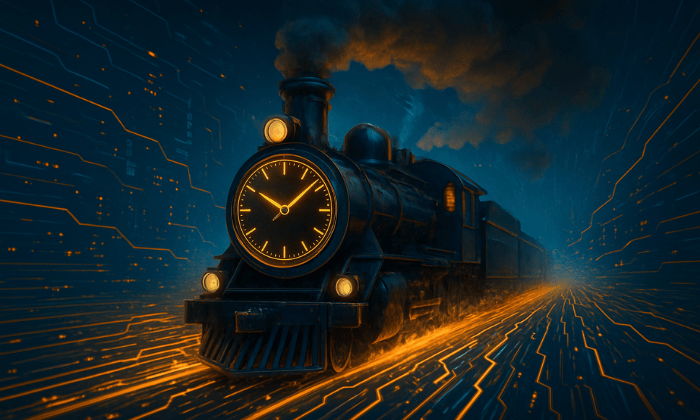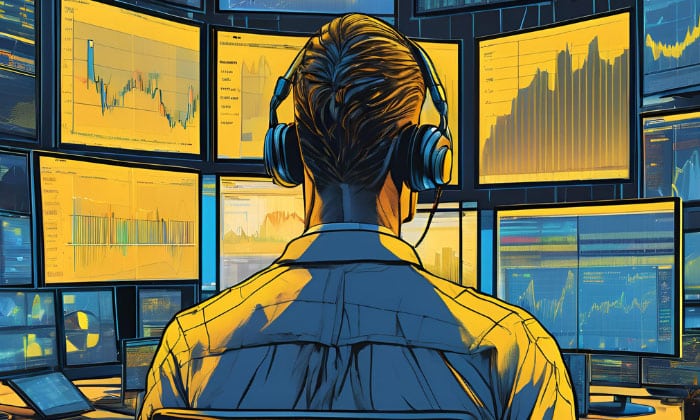Key Takeaways
- True AI decision-making demands deep temporal intelligence to perceive, reason, and act across time.
- Many AI systems falter because they treat time as a series of static timestamps, failing to grasp the causality and context that drive human judgment.
- Temporal intelligence combines streaming and historical data to enable AI that not only reacts in the moment but also learns continuously and anticipates what's next.
- From predicting asset volatility to detecting emerging health risks, industries gain a competitive edge when AI models can simulate and prepare for multiple futures.
- KX delivers the foundation for temporal intelligence with vector-native analytics that unlock faster, smarter decisions across dynamic, data-intensive environments.
“The distinction between past, present, and future is only a stubbornly persistent illusion.” — Albert Einstein
When a French audience first saw a cinematic train rushing towards them in 1895, people allegedly jumped out of their seats and fled from the theater. The Lumière brothers’ famous screening didn’t just make film history that day, it revealed how instinctively we all grasp time.
The audience saw the risk immediately, based not only on perceiving the speed and direction of the train in the present, but also on intuiting where the train would be in the future. That’s basic real-time temporal reasoning, and we all take it for granted. But could today’s AI make the same intuitive leap?
It’s a challenge we know well at KX, having powered the capital markets datasphere for over three decades. As discussed in my last blog, AI can certainly make informed, split-second decisions when underpinned by an ultra-high-performance analytics platform. We’ve long helped the titans of Wall Street do just that by finding patterns in vast streaming and historical data. Yet true temporal intelligence demands more.
Mind the temporal gap
“Time is the wisest counselor of all.” — Pericles
For all its computational speed, AI often lacks our natural, non-linear intuition about time: remembering relevant past events, understanding subtle chains of causality, and predicting diverse futures. And that’s a big problem, because temporal reasoning plays a critical role in how we make decisions.
As innovation theorist John Nosta points out in Psychology Today, “For AI, time is represented as timestamps in data, devoid of the past-present-future continuum that humans experience.” Likewise, researchers from the University of Edinburgh recently made headlines after showing that even state-of-the-art multimodal large language models struggle to understand basic time-related questions.
Let’s consider some simple examples to see how an inability to understand time can significantly impact AI performance across industries:
- Retail: Dynamic pricing systems react to competitor actions immediately but miss seasonal demand shifts based on long-term, historical trends
- Manufacturing: Predictive maintenance spots sudden anomalies in machinery, but fails to identify emerging failures from more subtle, moment-to-moment patterns
- Logistics: A system adjusts to live traffic data in real-time but can’t anticipate predictable disruptions from future weather events or national holidays
For AI to think not just quickly but wisely, we need to close this temporal gap. AI needs more than a simple, linear understanding of time, it needs deep temporal intelligence. To make context-aware choices, AI must be able to:
- Perceive time: Recognize sequences, durations, and rhythms in data streams
- Reason in time: Analyze causal links, correlations, and trends
- Remember the past: Leverage relevant historical context efficiently
- Anticipate the future: Forecast potential scenarios based on learned patterns
- Act in the present: Execute decisions in real-time
Building temporal intelligence
“What was most important wasn’t knowing the future, it was knowing how to react appropriately to the information available at each point in time.” — Ray Dalio
Unleashing temporal intelligence begins with the ability to store, retrieve, manage, and analyze rich time-series data. Unlike traditional approaches that struggle with time-stamped information, time series databases are purpose-built to blend streaming and historical data seamlessly.
When combined with optimized vectorization tailored for temporal context, time series data can capture evolving relationships and patterns. This enables AI to continuously learn from both past and present information and respond with real-time temporal awareness.
But data alone isn’t enough. Extracting value from temporal data at speed and scale requires advanced architectures like Temporal Convolutional Networks. Crucially, these architectures enable temporal inference – the ability to infer what comes next, fill in gaps, and model how a situation may evolve. This foresight is essential in dynamic environments, where simply reacting to the present isn’t enough.
Generative AI takes this a step further. When combined with temporal inference, it allows AI not just to predict a single outcome, but to simulate multiple plausible futures, whether that’s projecting traffic levels, retail demand, or the condition of a machine.
To make those projections more accurate and resilient, we can also apply techniques like backtesting (validating predictions against historical outcomes) and scenario modeling (exploring a range of future possibilities). This further refines AI temporal decision-making, much as people recall past experiences and consider potential consequences to weigh their choices.
The result is a new generation of AI systems that don’t just react in real-time, they can learn continuously from evolving data, they can make more accurate predictions based on deeper trends, and they can take proactive decisions.
What kind of impact could such temporal intelligence make? Let’s consider some industry use cases:
- Defense: Autonomous systems can integrate historical mission data with live sensor feeds, employing temporal inference to navigate complex environments and anticipate evolving threats based on learned patterns of movement and behavior.
- Healthcare: Diagnostic tools can blend long-term patient histories with real-time vital signs, using temporal intelligence to identify subtle, long-developing conditions and enable truly personalized, predictive, and preventative treatment plans.
- Capital Markets: Algorithms can use temporal inference to understand deep market rhythms, anticipate volatility beyond immediate fluctuations, and generate strategies to mitigate risk or capitalize on predicted opportunities.
The clock is ticking
“You may delay, but time will not.” — Benjamin Franklin
AI is no longer just a tool for data crunching; it’s evolving to complement and improve human judgement. As more and more industries race to accelerate innovation and decision-making with AI, only the fastest will survive.
However, real-time reactions alone won’t be enough to outrun the competition; you also need speed of insight. You need AI that’s capable of temporal decision-making to drive better choices in time-sensitive situations.
At KX, we’re pushing the boundaries of what’s possible with real-time temporal intelligence, enabling organizations to uncover patterns, trends, and anomalies in vast time series data through lightning-fast, vector-native analytics.
Unleashing the ability to make not just faster decisions but wiser ones, temporal intelligence will be the deciding factor in AI-driven success. Like that cinematic train in 1895, the future is coming fast and the real risk is falling behind.
AI is transforming industries at unprecedented speed, but temporal intelligence can only be built on the right foundation. See why the world’s leading firms trust KX to maximize AI’s value with real-time, high-performance analytics that power smarter, faster decisions.










